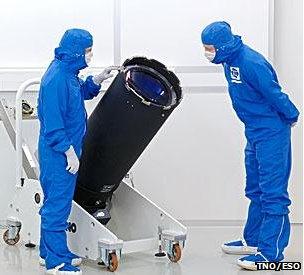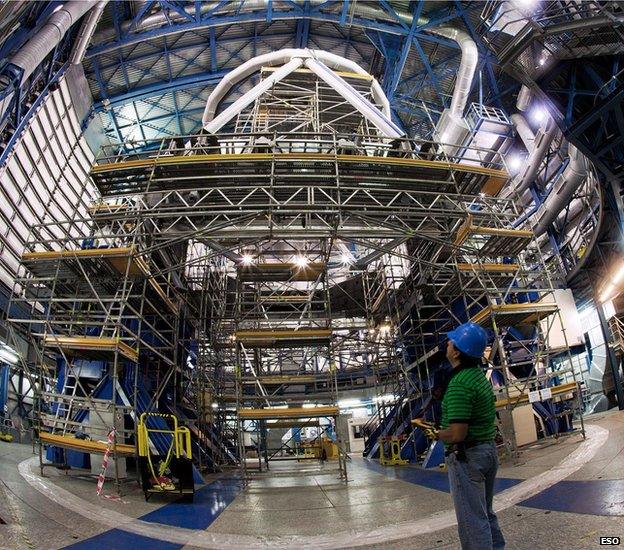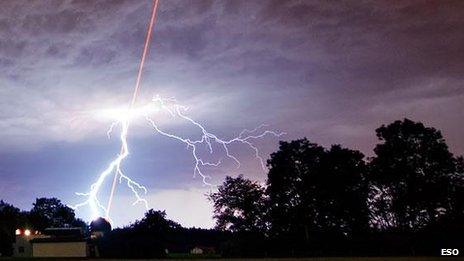Laser Guide Star at VLT to shine brighter light on stars
- Published
Scientists Frederic Gonte and Domenico Bonaccini Calia explain how the current and the new laser work
It does not twinkle, a rare characteristic for a star.
It appears suddenly over the southern hemisphere, a new neighbour in the crowded black sky.
But this "star" is not a real one.
Created by a powerful laser beam, it can be made to shine to order by the astronomers at the Paranal Observatory in Chile's Atacama Desert.
"We call it a Laser Guide Star, or LGS, and it is an artificial star that we create by illuminating the sodium layer of the atmosphere," explains Frederic Gonte, head of instrumentation at Paranal.
Clad in a white coat and overshoes, he stands in a tiny lab located high above the ground, in the heart of Yepun - one of the four units of the biggest optical telescope on Earth, the Very Large Telescope (VLT).
In front of Mr Gonte is a projector that is emitting a laser beam across the room.

The new unit will be extra compact, but much more powerful than the one currently at the VLT
The laser that we see is green, but then it is converted into yellow before it starts racing upwards, to the sky, through an opening in the roof of Yepun's huge enclosure.
Outside, the view is breathtaking: a huge beam disappearing somewhere inside the Milky Way.
For now, there is only one LGS unit at the VLT. Soon, there will be four - and they will be a lot more powerful.
Removing turbulence
Astronomers use a Laser Guide Star to obtain the best possible image of a celestial object.
"When a telescope points at a star from Earth, it encounters the turbulence of the atmosphere, and this turbulence makes stars twinkle and the image blurry," says Mr Gonte.
This means that although large ground-based telescopes with big mirrors can see much fainter objects in the sky than smaller telescopes, without any correction the resolution is generally no better than that of a 0.2m-aperture telescope.
When observed from the Hubble Space Telescope in orbit, for example, stars do not twinkle.
To correct the distortion and improve the resolution, astronomers use a technique known as adaptive optics.

Works are under way at Paranal to upgrade Yepun, one of the VLT telescopes that is also known as UT4, to receive the four new Laser Guide Star units
They find a bright reference star close to the object being observed and measure the blurring.
A deformable mirror in the telescope then largely cancels out the atmospheric distortion.
"Without the adaptive optics, a telescope like one of the VLT units has a no better resolution than a 20cm telescope," explains Mr Gonte.
"With the adaptive optics, it is better than Hubble."
But sometimes, there is simply no such bright star nearby - astronomers estimate that only about 1% of stars are bright enough for adaptive optics to work.
That is when scientists need an artificial one.
More powerful telescope
The laser pierces the atmosphere, giving birth to a "star" somewhere 90km (56 miles) above the Earth.
Even though to the naked eye this artificial star is still fainter than any natural one, it is bright enough to be a reference for astronomers to correct the effect of the turbulence.
The VLT is not the only telescope in the world that uses the Laser Guide Star system.

The VLT is able to link its four units together to create a huge virtual telescope with a much better zoom
But it will be the first one to receive a major upgrade of this technology.
Over the past several months, a team of engineers and scientists at the headquarters of the European Southern Observatory - the organisation that runs Paranal - in Garching, Germany, has been busy developing a new, much smaller, more mobile and significantly more powerful LGS unit.
A prototype was tested last summer.
"The new unit is going to have a lot more power to create a much brighter artificial star - while the current laser generates 5W when in the air, the new one will have 18W," says astrophysicist Domenico Bonaccini Calia, from the Laser Guide Star group at ESO.

The new LGS unit was tested on 18 August 2011 in south-west Bavaria, Germany
"It is really a breakthrough in laser technology, some of which we have patented here at ESO.
"The unit is very compact, requires much less maintenance, is much less delicate than the current one, and is remotely controllable without much human intervention."
Soon, the VLT's Yepun telescope will harbour four of these new devices, together called <link> <caption>4 Laser Guide Stars facility</caption> <url href="http://www.eso.org/sci/facilities/develop/4LGSF.html" platform="highweb"/> </link> - and is currently being modified to accommodate them.
The new units are expected to be shipped to Paranal in the coming months.
The same technology will also be installed on a telescope that ESO aims to build - on a mountain not far from Paranal, called Cerro Armazones.
If all goes according to plans, the new European Extremely Large Telescope (E-ELT) will have a mirror of some 39m in diameter and have six Laser Guide Star units installed.
"The E-ELT will use the Laser Guide Star routinely, right from the start," says Mr Bonaccini Calia.
"With a Laser Guide Star, it's like having a lamp on your hard-hat in a mine - wherever you look, you always have a bright star in front of you.
"And only 4-5% of the light from the laser gets absorbed - most goes into space and could reach other solar systems."
It will take a long time to do so, and when the light finally reaches an extra-solar planet, it will be very faint, adds the scientist.
But who knows? Maybe one day, it will be spotted by life forms elsewhere in the Universe.

The new telescope, called E-ELT, may be built in the coming years, and it will be using several laser guide star units right from the start
<italic>Katia Moskvitch was on secondment to ESO for two months leading up to her trip to Chile.</italic>
- Published28 March 2012
- Published3 February 2012
- Published12 October 2011
- Published21 September 2010
- Published20 October 2010
- Published25 May 2011